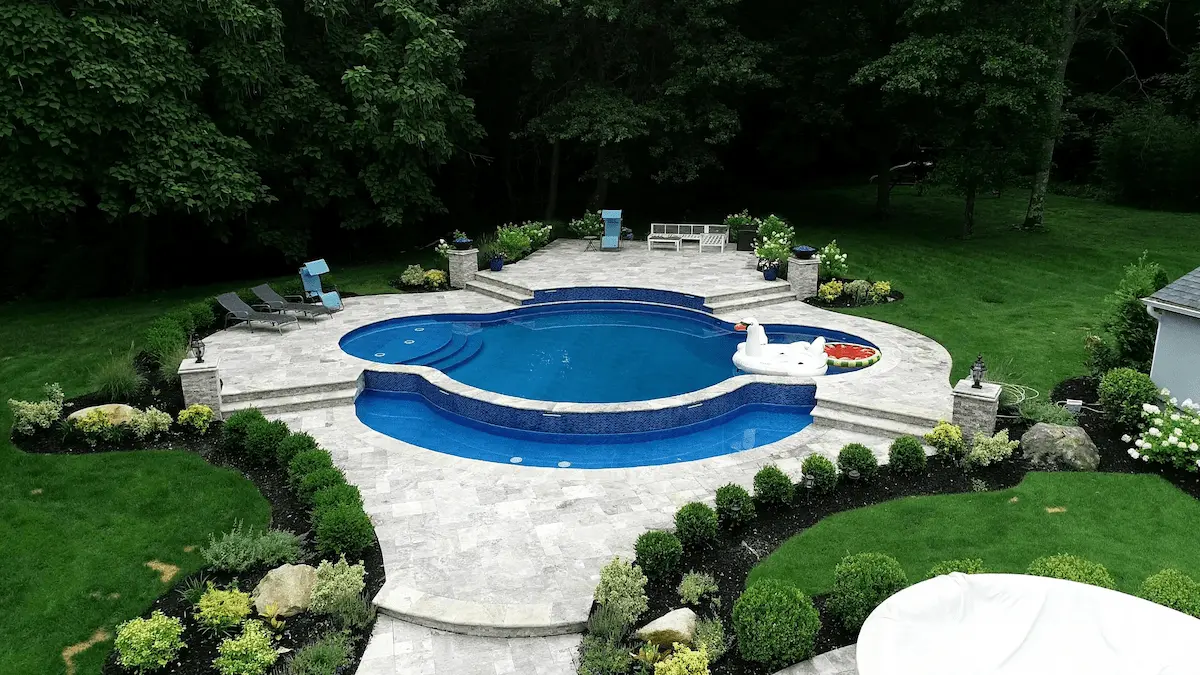The term “gunite” refers to the process through which concrete is transformed from a big old glob of thick gunk into a marvelous and useful swimming pool.
The gunite pool isn’t always easy to work with. It involves a lot of concrete. It’s an industrial material that dries quickly and stays very solid for a very long time.
Most of the time, most concrete construction used removable forms or molds to create shaped concrete, or workers would use concrete as a form of mortar to bind other materials together or to strengthen their exteriors.
How does the gunite process work?
Gunite uses pressured air and pushes the dried concrete mix through a tube. This dry mix combines with water in a nozzle at the end of the hose, which shoots the now-mixed concrete onto whatever surfaces it’s pointed at.
Gunite results in a relatively thin layer of wet concrete, which is blasted at high speed and pressure onto any surface to which it can adhere.
The combination of high pressure and a last-second mixture of the dry concrete mix with water needs to be conducted just right, or the final mixture may be too dry or become too wet and not adhere properly to its intended final surface.
Pros and Cons of Gunite Pools
Building an in-ground pool can take up to several weeks and even months to complete depending on the size. One of the main advantages of gunite is that you can stop the application, return the next day, and continue spraying without creating cracks or odd-looking finishes.
Because gunite is dispensed at such a great force, the new will bond to the old without creating a cold joint.
Unlike fiberglass pools, gunite pools can be made on-site which allows for more flexibility and is easier to install.
Gunite pools are incredibly durable and do not require a liner. This allows the pool to look better and retain its shape over time.
One of the main disadvantages of a gunite pool is the time it takes to install the pool from start to finish.
Gunite pools that are not tiled can sometimes seem rough to young children and have been known to snag a swimsuit. The rough surface of an un-tiled gunite pool can also house algae, so additional algaecide is needed to keep the pool pristine. There are several pool finishes that can be applied to your pool that will vary in texture.
Building a Gunite Pool
Choosing the right location for your pool is very important. Factors like underground lines and pipes, large tree roots, and slope must all be taken into consideration. It is imperative to choose a knowledgeable pool contractor so costly mistakes are not made.
Once the correct location has been chosen, it is time to dig out the area. In most cases, the dirt and rocks removed will need to be hauled off.
Once the area is excavated and the dirt smoothed, it is time to install the supports and install any plumbing.
A steel frame is installed next, covering the whole inside of the pool, and shaped accordingly. This steel frame acts as the base for the pool and allows the gunite to adhere. The gunite is then smoothed out before it dries.
The next step is to install any tiles or decorative basins for the pool. If the pool is not tiled, a layer of plastering in the color you chose will be added on top of the gunite.
The decorative edge or coping around the pool is actually very important. It not only provides a smooth surface for entering and exiting the pool, but it also provides a lip for the water to remain in the pool. The decorative edge can be made from a variety of materials such as shaped concrete, stone, tile, or brick.
Outside of the edge around the pool, the ground must be leveled and pathed. The size of the paved area outside of the pool will vary based on your preferences. Some people enjoy a large, paved area that acts as a patio to hold chairs, tables, and even fire pits.
Before the pool can be filled with water, the pump must be installed and all the plumbing and electrical hooked up. This is also the time when any additional water features and lighting will be installed.
By this point, the pool should be complete. The only remaining steps are to fill the pool and test the pump and any water features. You and your pool contractor can test chemical combinations and discuss any questions or issues about pool maintenance at this time.





